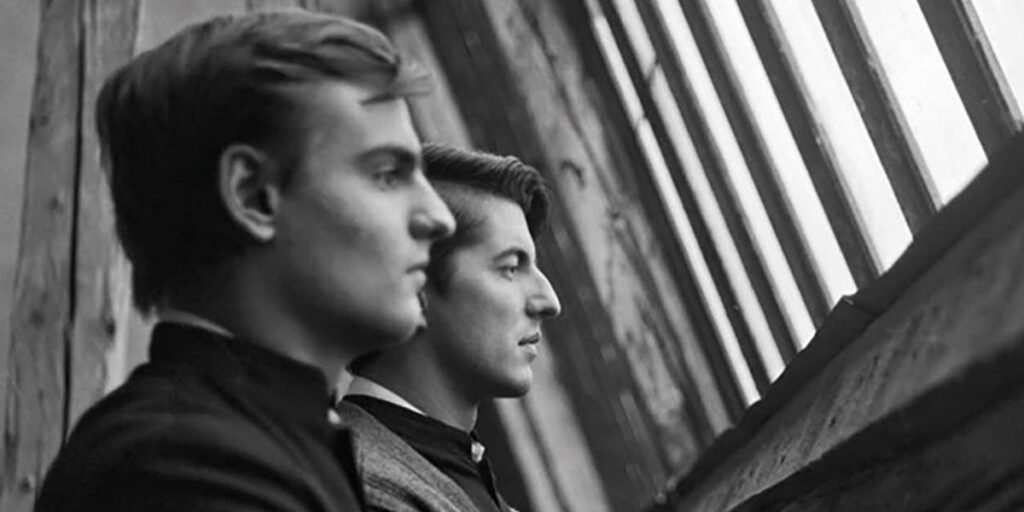Servants is an unforgettably chilling art thriller with some of the most striking images in recent cinema history.
It is not easy to be a good person living in the world: often, the morally right choices require the greatest sacrifice, while compliance is tantalizingly simple. The quest for individual purity is a theme that has existed for as long as stories have been around. In Ivan Ostrochovský’s second feature film Servants (now streaming on Kanopy in the United States) this struggle is brought front and center, telling the sparse but harrowing story of two boys attending a Catholic seminary in Czechoslovakia during the cold war, and the moral dilemma they have when the secret police penetrate the church and the priests they trusted with their physical and spiritual well-being begin to fail them.
Menace permeates the mood of Servants before we even see the first shoot. Over a simple black and white opening credits sequence comes a staticky radio message, someone codenamed “Three” has turned off their radio and the person on the other end of the line needs to contact them. “Three”, it turns out, is a Catholic Priest and Doctor who are hauling a corpse in the back of their car. It’s a chilly opening, shot in crisp black and white by cinematographer Juraj Chlpík, and the duo hauls the body out under a bridge. Overhead, a train barrels by, transporting tanks and other warfare materials and drowning out the sound of their movements. It’s a chilly juxtaposition, highlighting both the mammoth logistical elements of war while shadier activities happen just under the surface.
Then we are thrown back 143 days earlier, to the chronological beginning of the story. Prospective seminarians Michal (Samuel Polakovic) and Juraj (Samuel Skyva) arrive at their new seminary. Like most buildings in the Eastern Bloc, it is large, ancient, and lacking in materials. Chlpík makes ample use of the impressive space with a series of establishing shots that highlight the gothic nature of the building, most notably an underground sanctuary where the only light casts a ghastly shadow of the crucified Jesus on the wall behind it. Both boys are eager to develop spiritually far from the creeping hand of totalitarianism that grabs the country, but their first day has only just ended when the film cuts to its only scene outside of the seminary and without any of the major characters. The shot, a sea of interchangeable older men all raising their hands in unanimous agreement, hints at something darker only just being enacted that we will gradually become privy to.

What those men were voting on, it seems, is allowing the secret police to begin undercover work within the seminary, and it is this struggle that Servants spends the rest of the time exploring. Pamphlets begin appearing, typed by the students and urging political resistance. There are interrogations and disappearances, it is clear that the house of good is under siege by evil. These scenes take minimalism to the extreme, dialogue is rare and the shots are often voyeuristically wide, leaving us to interpret the story based on the actor’s body language, or so tight on the subject’s face that it feels like you’re trespassing on a private moment. This brilliant whiplash in framing helps further one of the central ideas of the film, that of personal resistance in a vast and often malevolent system.
This idea of resistance that Servants posits is also fascinating. As the young men begin to awaken to the corruption of their institution their resistance is not a flashy chance for fame but taken as a moral imperative, something they must do. Everyone is terrified of getting caught and yet their devotion to faith is so strong that it would be unconscionable to let it continue, even going so far as to initiate a hunger strike as a last resort. “Do not fear those who wish to break the body,” Says the voiceover of an anonymous student reading from a pamphlet. The idea of a martyr in the physical sense is roundly rejected by both the resisting boys and the priests under the thumb of the secret police. To kill your enemy when there is no official war underway would undermine everything that both sides are working towards. Suffering, already a hallmark of the priesthood, is brought concretely into reality through the emotional turmoil that each character faces, and through the physical danger that very well might come to pass.
Servants is not a film for the passive watcher. As stated before, Ostrochovský plays very coy with direct storytelling and often forces the viewer to explore the frame for the subtext that propels the story. Which makes the film’s emotional resonance all the more impressive when the final credits roll. To render a story full of internal struggle visually is no small feat, and to do so while also being chocked full of stunning compositions is even more so. It’s a shame that Servants did not receive a wider run, but hopefully, with its release on Kanopy, the film will get the wider audience and praise that it rightly deserves.
Servants is now available to watch on Kanopy in the United States.

